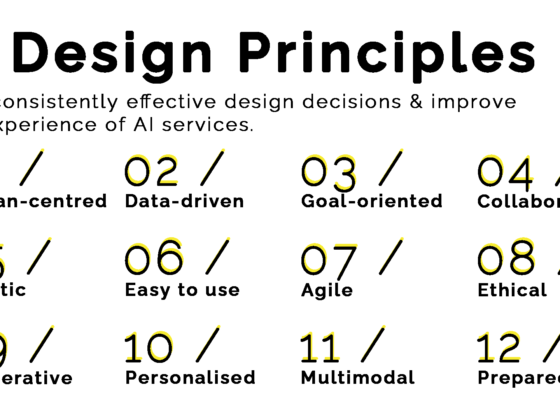How do you ensure you’re on the right track in conversational AI? How do you ensure you’re not wasting time and resources on something that won’t help anyone? Many designers keep principles in mind while they work.
Design principles are at best a great resource for aligning minds when people collaborate, and at worst a set of strict rules that nobody really understands or adheres to. That’s got nothing to do with the principles themselves – it’s all about how you apply them. They’re intended as a guide – a reminder of what matters so you don’t stray too far.
Recently Matt Portillo, Conversation Design Lead at Amelia was interviewed by Kane Simms for VUX World. It was right at the end of the conversation that Matt casually dropped a great resource into the conversation – Amelia’s 7 design principles. They were so good that they had to be reshared.
Always take ‘em with a pinch of salt
As Matt says himself, “I’m often asked for best practices. And I brush that aside, because when people ask me for best practices, they’re looking for a simplistic way of thinking.”
He recommends considering trade-offs when applying these principles because they’re sometimes in conflict with each other. Use your discrepancy. Judge what you think is appropriate depending on the context where you apply them.

Garnish your design process with Amelia’s 7 principles
Amelia’s 7 Design Principles
- Accessible – users interact wherever and however it makes the most sense for them
- Consider a medical use case – if users have a sore throat then they probably don’t want to talk much. If you must ask them lots of questions, then perhaps allow them to reply by pressing 1 or 2 rather than saying “yes’ or “no”.
- You might have promised a fancy solution, your client might want it, but what about the actual people who will use it? If you can make their experience more accessible then do it.
- Easy – minimise physical and mental energy required of users to get what they need
- Matt says “what is the user problem that we’re also trying to solve? How can we make users lives easier?”
- It’s advisable to get conversation design involved in a project as soon it it’s been confirmed. Their job then is not to begin the actual creation of conversational flows, but to have a say in the discussions about what will be built. UX matters – you have to have an advocate for the users involved when planning a project, and it will save a lot of pain down the line. Matt calls it ‘de-risking’ the project. Don’t just build the first idea that comes into your head – re-think it, test it, invest time in validating the concept before you commit.
- Efficient – make user’s journey seamless and allow them to move through quickly
- Beware of the sexy concept presentation. It’s just too easy to sell an idea that looks good as a prototype but doesn’t get users where they want to go. Once a project has been thoroughly researched, designed and built then you can expect to focus on fine-tuning. No bot is released into the world perfectly formed.
- As Matt says, “Are they able to get through it quickly? If yes, you’re good. If not, then keep working.”
- Useful – provide helpful, consummate experiences that resolve user’s needs, end to end
- This is perhaps the most important and the hardest of the principles to achieve – you need to consider your design with a wide lens and judge how it fits into user’s lives.
- Consider a user who has lost their password for a website and is locked out. If they contact customer support and are connected with a bot, the worst result could be for the bot to say “I understand you have a problem with your password – I’ll log a ticket for you.” That solved nothing. The user still can’t get into their account, and they could have logged the ticket by themselves in a much more efficient way (perhaps by using a webform where they log their contacts and the issue).
- “We’re looking for opportunities to provide helpful consummate experiences that, at the end, make users feel like oh wow, it took care of me! Thank you so much!”
- Conversational – give users equity in and control over the conversation, make it turn-based
- If you want users to talk with your bot, they have to be understood. Otherwise the whole experience falls apart. That means training your NLU (Natural Language Understanding) is massively important. Amelia’s NLU architects work very closely with their conversation designers to ensure the NLU is trained on the language of real users.
- But users may have the option of using buttons, gestures or any other modality instead of words. “The important thing is that users have equity in the conversation, they have some control over the conversation and it should be turned based.”
- Credible – build trust by providing accurate, reliable info in a smart, appropriate way
- If users get burned by your bot, they’ll give it a miss the next time. Trust is built over time. Bots must provide the best info they’re aware of, and they must deliver it in a way that’s correct for the context.
- Intelligent – understand like a human: be adaptive and prepared to handle the unexpected
- Matt referenced great advice from Salesforce’s Greg Bennett – “users should never have to change their language to be understood by a chatbot, or an assistant. It should be intelligent enough to understand users how they speak, and address whatever they might bring up.”
- So not only should your NLU be properly trained on the language of your users, but the bot itself should be ready to adapt to the user’s varying needs. Conversations evolve – someone calling up to ask for train times might suddenly remember they need to book a train ticket for the next day – a live agent would be able to adapt to the user’s evolving needs, and a bot should be able to adapt too.

Now it’s your choice how you use them
Principal of the designers
So there you have Amelia’s 7 Design Principles. Perhaps try them the next time you discuss a conversational project with a new client. If they don’t know much about conversation design, but they are prepared to challenge their assumptions, then these could be a great asset.
Thanks so much to Matt Portillo and Amelia for sharing these. Matt’s one of those designers who’s well worth following on LinkedIn so you catch the great insights he shares.
You can hear Matt’s full interview here.
This article was written by Benjamin McCulloch. Ben is a freelance conversation designer and an expert in audio production. He has a decade of experience crafting natural sounding dialogue: recording, editing and directing voice talent in the studio. Some of his work includes dialogue editing for Philips’ ‘Breathless Choir’ series of commercials, a Cannes Pharma Grand-Prix winner; leading teams in localizing voices for Fortune 100 clients like Microsoft, as well as sound design and music composition for video games and film.




